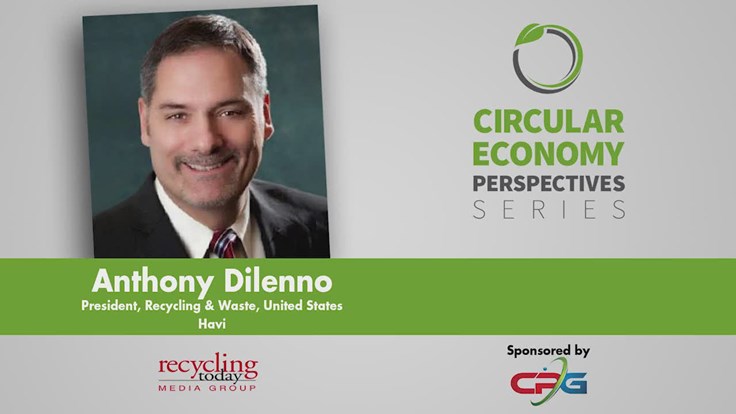Pictured from left to right, Ljupka Arsova, Gershman, Brickner & Bratton; Luc De Baere, Organic Waste Systems; Alan Johnson, quasar energy group; and Erik Herbert, Zero Waste Energy.
Anaerobic digestion (AD) is a technology that has many challenges, especially in an era of low energy prices and less government incentives. But speakers at the 2016 Renewable Energy from Waste Conference shared how many opportunities still exist to create value in the form of on-site energy, fleet fuel and compost.
During a session titled "Opportunities in biogas," Eric Herbert, founder and CEO, Zero Waste Energy (ZWE), Lafayette, California, told attendees that it is important to make a project effective, efficient and ultimately what the customer needs. “Creating a project that delivers is hugely important,” he emphasized.
The company is a subsidiary of Bulk Handling Systems, Eugene, Oregon, which Herbert says allows the company to put together an entire system. The company, he says began, because they saw here in the California market that the push was going to be on that next level of diversion on organics. Anaerobic digestion was employed in Europe and successful there.
He said, when the company first got started in AD, the idea was to create electricity. About five or six years ago, there was an investment tax credit that was all about creating electricity. Amount of capital, 30 percent would be an energy tax credit. Because of the financial meltdown in 2008, the Recovery Act was formed which said rather than take a tax credit, We will give you cash instead,” Herbert described.
“We thought that was pretty cool,” said Herbert. “But that is all gone.”
ZWE built projects in San Jose and Monterey County, California with those incentives, he said. It matched pretty well with what the EU was doing, according to Herbert, the economics of which pulled the projects forward.
“Our project in Monterey was the first to go through the U.S. Treasury as a dry AD project using source separated food waste project to actually get that 1603 credit.”
He said it took about 8 months of him convincing the U.S. government that it was going to work. Then, a few years later, natural gas production rose and prices fell. “Power was dead,” is what Herbert says everyone was saying.
“Power generation is a great opportunity,” said Herbert. “It still exists. The economics are not nearly as attractive as they were before.”
Where he sees it working best is “behind the gate,” where it is both generated and consumed on-site. It offsets retail prices rather than trying to sell it to a utility company that “doesn’t want your power.”
Compressed natural gas (CNG) is another opportunity. In Southern California, the air district started requiring use of CNG trucks to reduce emissions. Then the price the natural gas started dropping and everyone thought it was a good idea, he said.
Putting it into the natural gas pipeline is also very doable, according to Herbert.
He also talked about closing the loop. The plant ZWE built in South San Francisco, Blue Line Biogenic CNG Facility does just that. Herbert described how beneficial a closed loop system such as this is from a greenhouse gas perspective.
The California Air Resources Board says a system where trucks collect organics, bring them back to the yard, use dry AD to create fuel and put it back in the trucks has a -21 or larger intensity, whereas diesel would be at 102. “It is probably one of the biggest greenhouse gas reduction programs a city can go into,” he said.
The San Jose was one of the last we did on a power project. PG&E; was not overly thrilled with buying the power. The results are good, plants run well, does produce.
Project working for city of Napa, California and Napa Recycling, at a local transfer station. “Everything will be inside the fence,” said Herbert. The facility is expected to be online early in 2017 and will produce CNG to fuel the trucks.
Alan Johnson, vice president, project development and engineering, quasar energy group, said the company built its first digester in 2009 at Ohio State and since then has completed 14 projects in Ohio, New York, Maine and Massachusetts investing $150 million. It managing 700,000 tons of material per year, 40 percent of which is wastewater treatment plant biosolids. It manages about 10 percent of all biosolids generated in Ohio. The facilities are mostly located on dairy and pig farms.
He referenced a white paper The Water Resources Utility of the Future: A Blueprint for Action which he said got wastewater treatment plants to look at themselves differently. “The Utility of the Future transforms itself into a manager of valuable resources, a partner in local economic development, and a member of the watershed community seeking to deliver maximum environmental benefits at the least cost to society,” the report states.
Johnson said quasar is talking to its clients about extracting nutrients from the water source, capturing energy value and using those to help run their plants.
He said utilities today are facing capital, technical and regulatory challenges and that money has simply dried up. Something like AD can help them convert themselves from a line item on a city’s budget to cash flow generation.
“Treatment plants use about 3 percent of all the U.S.’ electricity, but by combining biosolids with food waste at these digester plants, they have the capability of producing 12 percent of the generation of the demand for electricity for our country,” Johnson said.
At Quasar’s digester project at the Wooster, Ohio, wastewater treatment plant, biosolids and food waste are codigested, which enhances the energy production, to take the plant of the grid.
Wooster plant takes in 73 wet tons per day. Daisy Sour Cream built a plant and hired 300 people because they could plug into the system. By bringing in merchant biosolids, including brewing waste, fats, oils and greases (FOGs), glycerin, grease trap waste, this plant makes 910 kilowatt (KW) hours per hour of energy, which completely offsets not only the WWTP but the water treatment facility.
“They’ve become completely energy neutral,” Johnson told attendees. He said quasar provided a way for the municipality to save money, eliminate risk, and allow the municipality to focus on its core competencies. Quasar streamlined the process, and provided stability with a long-term contract, versus taking a public pathway, Johnson described.
Luc De Baere, general manager and the managing director, Organic Waste Systems, Belgium, said, acknowledged that likely the most difficult feedstock for AD is the organic fraction for mixed municipal solid waste, with the contaminants and inerts.
“That is a challenging fraction for everybody,” he said. “What we have developed with OWS is a system that produces high-quality compost and simple recyclables from the mixed waste digestate that we are producing.”
He said OWS has constructed about 30 handling municipal solid waste source separated organics from household waste, mostly in Europe, with a couple in Japan and South Korea. It’s oldest plant in Germany is about 20 years old.
Food waste and other organics in MSW are the largest potential for increasing diversion and recycling that still has not been tapped. If we can develop on a fullscale systems that create clean compost and recyclables then 90 percent diversion becomes reachable.
The challenge he said is that mixed household waste compost is low quality. An AD solution OWS offers starts with the Dranco solution, which is 30-40 percent solids coming out of the digester, contains, glass, stone and sand.
He described the benefits of the system as follows:
- ·no phase separation;
- ·no scum formation, no settling in the tank;
- minimal heat requirements;
- intensive and reliable digestion;
- less intensive pre-treatment;
- high flexibility (total solids content in digester 15 to 40 percent);
- ·no mixing equipment inside the digester;
- simple digester (conical);
- avoids or minimizes wastewater production;
- soiled paper allowed in the feedstock, even beneficial.
He noted that paper is beneficial in the system because it increases methane yield by as much as four times. OWS developed this process for digestate because by treating the digestate, De Baere said, the company either had to dry it because we could not aerate it or add water to it and start separating out the contaminants and the material.
OWS developed a system with a dry sorting system like a dirty MFT, to produce RDF, metals, at the beginning, then it goes through the Drano digestion, take the wet digestate to a wet separation, called Sordisept where the light plastic faction is taken out, allow heavies to settle and you take out the organic fraction and stabilize it and create a clean compost from that material.
The session was moderated by Ljupka Arsova of Gershman Brickner & Bratton, Fairfax, Virginia. The Renewable Energy from Waste Conference was Nov. 14-16 at the Westin Long Beach in Long Beach, California.



